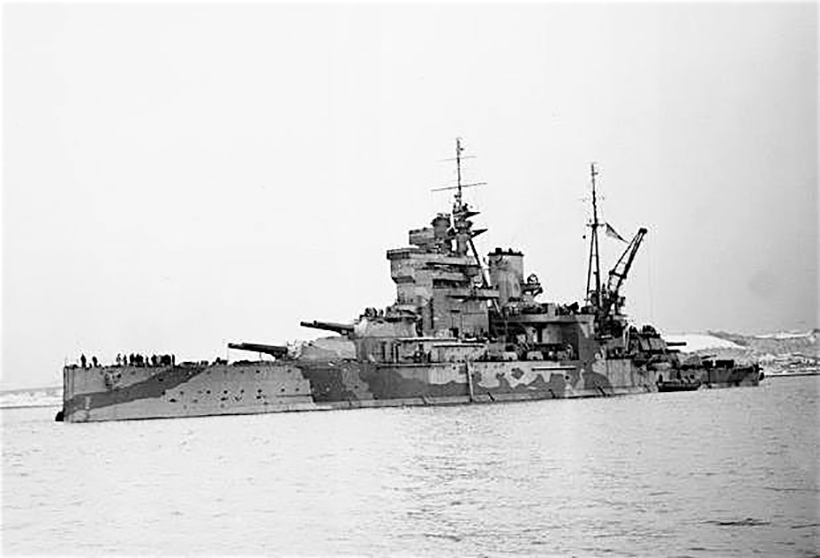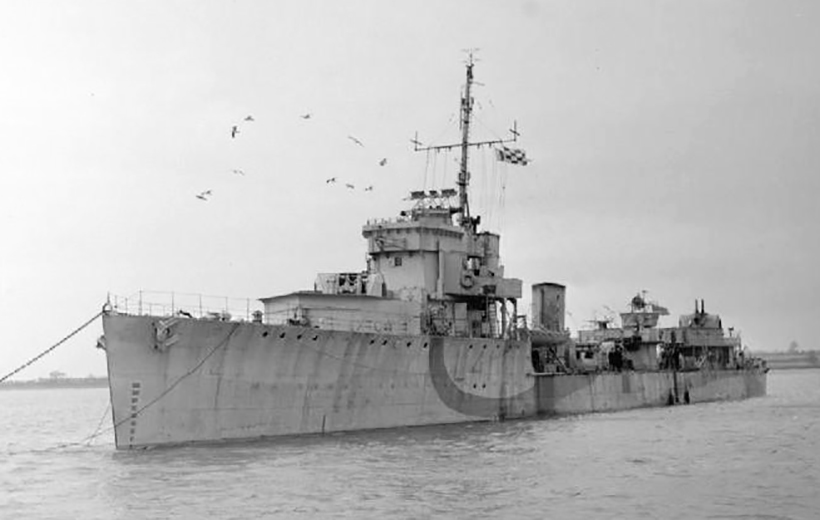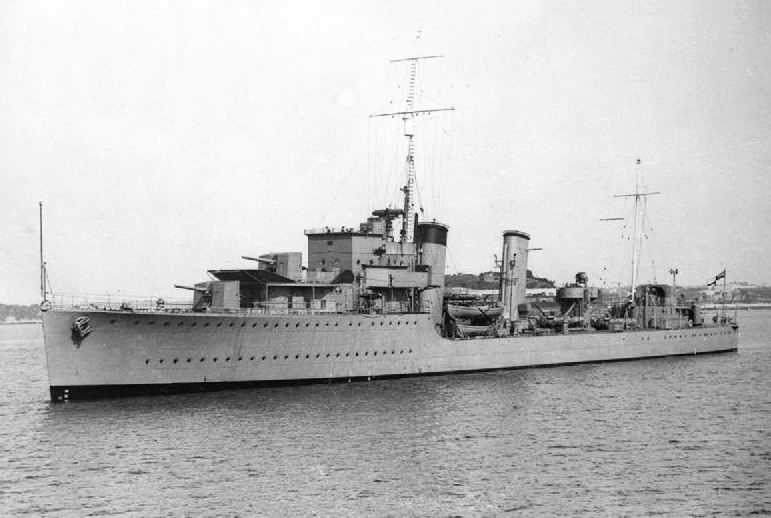What’s the link between the Royal Navy and the Spanish Civil War?
Posted by Chris Graham on 15th April 2020
The Royal Navy and the Spanish Civil War are more linked than many of you may realise. We explain what really happened between 1936 and ’39.

The Royal Navy and the Spanish Civil War: The County-class cruiser HMS London was put on standby in Gibraltar, during the Spanish Civil War.
While plenty of you will be familiar with the unofficial involvement of British volunteers in the conflict that brutally divided Spain during the pre-Second World War years, fewer of you may be aware that the Royal Navy and the Spanish Civil War are inextricably linked, too. The navy was involved not as a protagonist, you understand, but in support of the international policy of non-intervention, and to help with maintaining the safety of non-combatants at sea.
However, don’t imagine for a minute that this task was insignificant. Taking August 1936 as an example, no fewer than 59 RN ships were deployed on various activities, encompassing evacuating tourists of many nationalities, protecting merchant ships and undertaking non-intervention patrols.
Civil War background
The Spanish Civil War was fought from 1936 to 1939, between a conservative rebel group, led by General Francisco Franco – known as the Nationalists – and the country’s left-wing, Republican government. Internationally, it tended to be viewed through a prism reflecting the political climate. Republican sympathisers saw it as a struggle between freedom and tyranny, while Nationalist supporters regarded it as a fight between Christian civilisation and what they regarded as ungodly Communism.
Both of these entrenched attitudes were reinforced by support from Nazi Germany and Fascist Italy for the Nationalists, and the Soviet Union for the Republicans. Perhaps both cynically used the hostilities for their own political, diplomatic ends and, as a training and testing ground for their forces, tactics and equipment by supplying men, arms and training to their surrogates in Spain. Additionally, there were idealists who travelled to Spain to fight, mostly on the Republican side, who formed ‘International Brigades’.
Its conflict of ideas influenced the politically aware classes in the Western democracies, and marked the fault line between the beliefs of the political left and right. Because of the intensely strong feelings generated on both sides, the conflict was almost pathologically brutal, with religious fanaticism, class hatred, political dogma and foreign intervention inflaming the violence.
Widespread devastation
As a result, large areas of the country were devastated. The war’s toll saw many dead and maimed, with families were split and scarred. Eventually, after three years, the Nationalists won, ushering in the 36-year-long rule of General Franco.
From the outset, a number of countries – primarily Britain and France (who were officially neutral) – were concerned about the possibility of escalation and expansion of the war to other states. To prevent this, in August 1927, a group of 27 states including Britain, France, the Soviet Union, Germany and Italy, signed a Non-Intervention Agreement, which set up a Non-Intervention Committee (NIC).
The principal goal of the committee was to control materials entering Spain, and included an arms embargo, which ultimately proved almost impossible to achieve – particularly as some signatories of the agreement were complicit in breaking the terms of the embargo. To fulfil the goal, however, required the services of the navies of several signatories to the agreement.

The battleship HMS Queen Elizabeth was just one of 33 Royal Naval warships operating off the Spanish coast in 1939.
The Royal Navy’s role
The Royal Navy was involved from beginning to end in the conflict. Initially it evacuated civilians – a job it tackled with the service’s usual ‘get on with it’ energy and drive. Its next priority was the protection of British merchant shipping around the Spanish coasts.
As the Civil War developed, international agreement was reached regarding setting up Non-Intervention patrols by neutral navies, to create a sort of cordon sanitaire off Spanish ports, which would restrict the import of arms, but allow foodstuffs and other essentials of life to pass. Different countries were allotted specified areas to patrol.
To provide its patrols, the RN stationed a destroyer force, backed up by heavier vessels, to deter interference by warships of either warring side. Later on, minesweepers were added to relieve the strain on the destroyers.
The rebellion which ignited the war began in July 1936, more or less at the height of the tourist season. Although tourism was then a relatively small-scale industry in comparison with today, there were still plenty of people enjoying the Spanish sunshine. Hence, large numbers of foreigners were trapped and needed help to escape the conflict.
The RN was geographically well placed to deliver this assistance, as Spain sat between the Home Fleet and the Mediterranean Fleet, and also close to the base and dockyard at Gibraltar. The Mediterranean Fleet had, in fact, been strengthened because of the Ethiopian crisis, and the continuing unrest in Palestine. Consequently, this fleet was responsible for operations on Spain’s southern and eastern shores, while the Home Fleet looked after the northern coast, as far south as the Portuguese border.
Rapid reaction
Soon after the rebellion had started, three cruisers and six destroyers were on station, with more ships on their way. W-class destroyers Wren and Witch were at the northern ports of Ferrol and Corunna; the cruiser Orion was between the Balearic Island of Majorca and Barcelona; and the destroyers Shamrock, Keppel and Whitshed were standing off southern coast ports.

Leader-class destroyer, HMS Keppel, operated off the Spanish southern ports.
To back them up, the battlecruiser Repulse and the 8in cruisers Devonshire and London were on standby at Gibraltar. The destroyers Gipsy, Gallant, Douglas, Keith and Garland were sent to ports on the north-east coast, while Wishart, Boadicea, Basilisk, Vanity, Veteran and Verity steamed to other ports.
In the first phase of the evacuation, which lasted until October 1936, more than 11,000 people were rescued by ships of the RN. Of those, about one third were British nationals. In parallel, the French, US, German and Italian navies undertook similar evacuations.
There were further evacuations throughout the war, particularly towards the end of the conflict when, among others, the RN carried away Republican Government members, to exile in France.
The military historian Antony Beevor in his book The Spanish Civil War, gives some idea of the desperation of Republicans to get away from the victorious Nationalists, fearing reprisals. He states that at the principle Mediterranean ports: ‘Between 40,000 and 80,000 people were trying to find space on ships which were leaving the country.
‘At Alicante, where up to 40,000 people were said to be thronging the port, several ships approached, but turned away when their captains saw that they would be stormed by the multitude. A number of soldiers and civilians on the quay then committed suicide, some even using bayonets.’
Merchant ship protection
From the start of the Civil War, patrols were set up to protect the large quantity of merchant shipping transiting the Straits of Gibraltar. On several occasions, RN ships came under fire, although without much effect, and with no casualties sustained. However, the destroyer Shamrock was damaged from near misses by Republican bombers, most likely the result of the airmen’s lack of proficiency in warship recognition. As a result, they might easily have been confused by the similarity in design of the British and Spanish destroyers and cruisers.
Both of the combating sides attempted to enforce blockades of their enemy’s ports. To protect British blockade runners, the RN maintained a presence close to most Spanish ports, usually two ships at a time, although the major port of Barcelona was allocated six vessels.
The scale of the RN’s operational commitment is indicated by taking a snapshot look at August 1936, when 33 British warships were on station, including the battleship Queen Elizabeth and the cruisers Shropshire, Galatea and Amphion (transferred to the Royal Australian Navy in 1939, and renamed Perth) in addition to those already mentioned, plus a force of 26 destroyers.
Admiral of the Fleet, Viscount Cunningham, who was Second in Command of the Mediterranean Fleet for a period during the Spanish Civil War, observed in his autobiography, A Sailor’s Odyssey: ‘Attracted by the enormous profits to be made by running cargoes into ports of one side or the other, certain British ship owners were operating whole lines of steamers to break the blockade. They were constantly getting into trouble. It had been customary to maintain a British squadron, and a Flag Officer, at Palma, Majorca. It was the Flag Officer’s rather difficult and unsavoury task, to see that British shipping was not unnecessarily molested.’
Later, the Italian Navy became more overtly involved on the Nationalist side, and sank a number of vessels it believed were carrying arms from Russia to the Republicans.
Non-intervention patrols
The Non-Intervention Agreement negotiated quite early in the war, had the objective of managing the arms blockade, and was administered by the NIC. For Great Britain, this had the support of legislation: The Carriage of Munitions to Spain Act, which prohibited arms being shipped to Spain in British merchant ships.
The embargo divided the Spanish coast into eight patrol zones, which were allotted to Great Britain, France, Germany and Italy. In them, their navies were required to stop and inspect vessels on passage to Spanish ports, to ensure that they had observed the regulations.
A number of Observation Points were set up to control seaborne imports into Spain, including the Downs near Dover, Gibraltar, Marseilles, Cherbourg and several other ports. At these points, vessels had to submit to inspection, to ensure the regulations were followed, and embark observers.
The RN was assigned two extended sections of the Spanish coast to patrol – from the Portuguese border southwards, through the Straits of Gibraltar, to Cape Gato, just to the east of Almeria, and from the French border westwards, most of the way along the Biscay coast to Cape Busto, including the ports of Bilbao and Santander.
Additionally, the land border crossings with France and Gibraltar were closed to arms exports, and arrangements were put in place to restrict arms flowing through Portugal. However, tensions proved inevitable as Germany and Italy supported the Nationalists, and the USSR supported the Republicans – and they all supplied their client sides with arms and troops. Unsurprisingly, incidents frequently occurred involving the RN and the combatants.

HMS Whitshed was one of 44 Royal Navy destroyers involved in important, safety-related operations during the Spanish Civil War.
Notable incidents
On one occasion, the destroyer Brazen went to protect the British merchant ship, Thorpehall, which was sailing to Bilbao carrying food. She’d been fired upon by a Nationalist armed trawler.
As Brazen arrived on the scene, the Nationalist light cruiser Almitrante Cervera also appeared, and Brazen’s captain put his ship between Thorpehall and the cruiser. Two other British destroyers – Blanche and Beagle – then arrived, and they were able to escort Thorpehall into Bilbao without further problem.
The Thorpehall incident made it obvious that a formidable force was essential to deter Spanish warships of either side from firing on merchant ships. Hence the RN deployed and maintained a powerful squadron in its patrol areas.
Nonetheless, there was a further incident in April 1937, again involving the Almitrante Cervera, plus an armed trawler. The cruiser fired across the bows of three British merchant ships, Macgregor, Hamsterley and Stanbrook, as they approached Bilbao. Fortunately, the battlecruiser Hood and the destroyer Fearless were in the vicinity and they warned the Spaniards off, although the Spanish commander claimed the territorial waters extended six miles out to sea. The British rejected such an exaggeration, and the Spanish backed down in the face of Hood’s overwhelming firepower.
Both sides in the civil war mined areas off ports and, in May 1937, the destroyer Hunter struck one off the Republican held port of Almeria, killing 13 sailors. Later that month, Republican aircraft dropped bombs near the destroyer Hardy.
German casualties
But it wasn’t only British warships which were attacked. At the end of May, the German panzerschiffe (pocket battleship) Deutschland, was bombed by Loyalist aircraft while lying off Ibiza, killing 31 and injuring 67. The Germans retaliated when Deutschland’s sister ship Admiral Scheer, in company with cruiser and four destroyers, bombarded the port of Almeira. In another incident, the German destroyer Albatross suffered near misses in a bombing attack.
Then, three weeks after the Deutschland attack, there was the curious incident of an alleged attack on the German light cruiser, Leipzig, which probably never happened. She reported being attacked by torpedoes fired by an unknown submarine off the Algerian coast, near Oran. However, the only evidence was noises heard through her hydrophones.
Both these incidents flowed from the increasing tension between the Germans and the Republicans, as the Germans had been actively involved in supporting the Nationalists on land, and in the air, almost since the start of hostilities.
Provokingly, Antony Beevor argues that, in practice, the British stance on non-intervention may not have been quite as even handed as the official policy suggested. He states: “The actions of the Royal Navy were astonishing for a non-interventionist power. Not only were communications facilities provided for Franco in Gibraltar, but the battleship HMS Queen Elizabeth was moved in front of Algeciras Bay, to prevent Republican warships shelling the port… The German Charge d’ affairs, Hans Voelckers, later reported: ‘The British cruiser commander here (Gibraltar) has recently been supplying us information about Russian arms deliveries… which he certainly would not do without instructions’.”
Italian involvement
In the summer of 1937, massive supplies of armaments for the Republicans started arriving from the USSR. As a result, General Franco, the Nationalist leader, asked Mussolini for help in halting the flow, and the Italian Navy and Air Force were ordered to interfere covertly with these imports.
By the end of September, 38 merchant ships had been attacked, nine of which were sunk, and eight damaged. While Italian destroyers and Italian aircraft operating from Majorca were involved, most of the operations were conducted by submarines. These occurred mainly in the Aegean, the Straits between Sicily and North Africa and some to the south of the Dardanelles. The intention was to stop the flow of arms from the Black Sea.
Admiral of the Fleet, Lord Cunningham, commented in his autobiography: ‘In the Autumn of 1937, another rather sinister development had arisen, and this was when British ships on the Spanish coast, indeed in other parts of the Mediterranean, were being sunk without warning, apparently torpedoed by submarines. The Spanish claimed the submarines were Spanish, though actually there was no doubt they were Italian.’
The RN was well aware of the identity of the attackers through signal intelligence and, as a result, more destroyers were deployed to the Mediterranean to protect British shipping.
In August 1937, the Italian submarine, Iride, unsuccessfully attempted to torpedo the British destroyer, Havock, which then replied with depth charges and frightened the submarine off. By now, the Non-Intervention Agreement had become ineffective, and another diplomatic initiative – the Nyon Agreement – was concluded which allowed counterattacks upon submarines, surface vessels and aircraft trying to sink merchant ships.
As a result, the RN strengthened its patrolling throughout the Mediterranean, and deployed more destroyers in what became known as the Nyon Patrol. It peaked at four flotillas, a total of 36 ships, or roughly half its destroyer force. In addition, two squadrons of flying boats from the RAF’s Coastal Command were stationed at Arzeu, near Oran, in Algeria.
Baleares action
The RN’s presence also brought humanitarian benefits, as illustrated by the Baleares incident. In the early hours of a March morning in 1938, the destroyers Kempenfeldt and Boreas[1] saw gunfire flashing on the horizon. A Nationalist convoy, escorted by three cruisers, was being attacked by a Republican cruiser and two destroyers. During the encounter, the Nationalist cruiser Baleares was cut in half by torpedoes, and her consorts disappeared.
Both British ships steamed towards the gun fire and, once they reached the scene, lowered their boats to rescue Spanish sailors in the oil covered water. Kempenfeldt manoeuvred alongside the blazing and sinking stern portion of the cruiser’s hull, to take on board numerous survivors. The two destroyers rescued 470 Spanish sailors.

The C-class destroyer, HMS Kempenfeldt, was involved in a daring rescue mission that saved 470 Spanish sailors from a blazing cruiser.
Many of the survivors were transferred to the two Nationalist cruisers which appeared later that day. But during that evolution, Republican aircraft attempted to bomb the two cruisers, and caused some splinter damage.
The Baleares episode demonstrated the Royal Navy’s training, professionalism and commitment. Going alongside a blazing wreck at night is a difficult and hazardous operation under any circumstances. But for the RN’s involvement, the death toll would have been much higher. It was but one example of the high standards the Royal Navy displayed throughout the struggle.
British warships continued their patrolling and protection tasks until the end of the War, and undertook further evacuations as the conflict drew to a close.
Major Royal Navy Ships involved [2]
Such a large number of RN warships were involved in the Spanish Civil War that the following list reads like the pages of a pre-War edition of Jane’s Fighting Ships.
Ship Class
Battleships
Royal Oak Revenge-class
Resolution Revenge-class
Queen Elizabeth Queen Elizabeth-class
Battlecruisers
Repulse Renown-class
Hood Hood-class
Aircraft carrier
Glorious Courageous-class
Cruisers
Penelope Arethusa-class
Galatea Arethusa-class
Orion Arethusa-class
Leander Leander-class
Amphion Leander-class[3]
Coventry C-class
Curlew C-class
Delhi D-class
London County-class
Devonshire County-class
Sussex County-class
Shropshire County-class
Destroyers
Basilisk B-class
Blanche B-class
Boreas B-class
Brazen B-class
Brilliant B-class
Boadicea B-class
Beagle B-class
Keith B-class
Kempenfeldt C-class
Comet C-class
Encounter E-class
Electra E-class
Forester F-class
Foxhound F-class
Firedrake F-class
Fame F-class
Fortune F-class
Greyhound G-class
Grafton G-class
Gallant G-class
Gipsy G-class
Gallant G-class
Garland G-class
Hardy H-class
Hunter H-class
Hyperion H-class
Havoc H-class
Intrepid I-class
Impulsive I-class
Keppel Leader- class
Mohawk Tribal-class
Maori Tribal-class
Afridi Tribal-class
Sikh Tribal-class
Shamrock S-class
Veteran V-class
Vanoc V-class
Vanity V-class
Verity V-class
Wishart W-class
Wren W-class
Witch W-class
Whitshead W-class
Douglas Scott-class
[1] BOREAS was commanded by Lt Cdr G B Roope who earned a posthumous VC when he rammed and damaged the German heavy cruiser ADMIRAL HIPPER while commanding the destroyer GLOWWORM, during the 1940 Norwegian Campaign.
2 This list is as accurate as it has been possible to make it, but is not exhaustive.
3 Transferred to the Royal Australian Navy in 1939 and renamed PERTH
For details about more War at Sea content, simply click here





